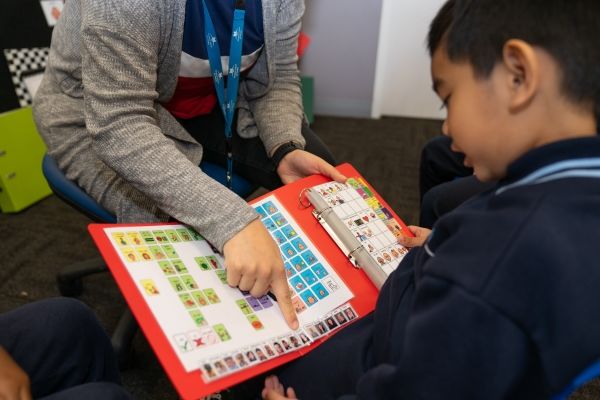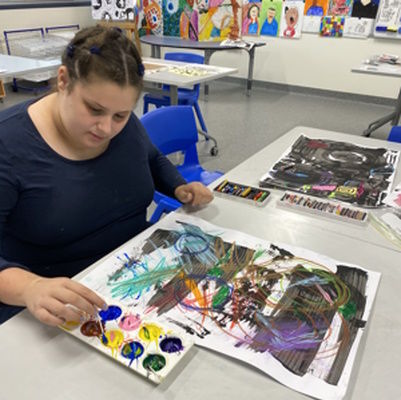Student Enrolment
All students attending NSA must have a primary diagnosis of Autism.The following enrolment criteria have been specified and approved by the Department of Education of Training. A student’s enrolment will be reviewed periodically in line with their needs. Eligibility must be confirmed before a place can be offered. To discuss a possible enrolment please contact the school: Telephone 03 9462 5990 Email: roselyn.datiles@education.vic.gov.au |
Enrolment Criteria & Procedures
01.Students seeking to enrol must have all of the following: A. A multidisciplinary diagnosis of Autism Spectrum Disorder; B. Significant deficits in adaptive behaviour established by a composite score of two standard deviations or more below the mean on an approved standardised test of adaptive behaviour (for example a Vineland Adaptive Behaviour Scales composite score of 70 or below); C. Significant deficits in language skills established by a comprehensive speech pathology assessment demonstrating language skills equivalent to a composite score of two standard deviations or more below the mean, (for example a core language score of 70 or below on one of the recommended comprehensive language tests). | 02.Evidence and Supporting Information RequirementsTo support a student’s application for enrolment, the following evidence and supporting information should be provided: A diagnosis provided by professionals with experience and knowledge in the assessment of Autism Spectrum Disorder that includes: A. A comprehensive report from a child psychiatrist or paediatrician; B. Concurring reports signed by a psychologist, including a comprehensive assessment of adaptive behaviour (not more than 12 months old); C. A signed report from a speech pathologist containing a comprehensive speech pathology assessment (not more than 12 months old) and where appropriate, an occupational therapist. |
03.Submitting an ApplicationIf a provisional place is available and all documentation provided is clearly within the eligibility criteria, NSA or the student's existing school can submit a Specialist School Enrolment Verification. Enrolment at NSA will only process once the school has received confirmation that the student is eligible.
| 04.Disability Inclusion ProfileNorthern School for Autism will be participating in the Disability Inclusion Profile from March 2024. The Disability Inclusion Profile will help us find out more about your child’s strengths and needs. It will inform personalised funding allocations and help us plan the adjustments a student may need to learn and participate at school. As we transition to this new funding model, families will be asked to attend a meeting to complete a Disability Inclusion Profile for their child. This meeting will be scheduled after your child has been attending NSA for two months. |
IntegrationMany students at NSA participate in dual enrolments with mainstream schools. NSA supports, encourages and prepares students for inclusion, on an as needs basis, by agreement with parents and carers. Integration Policy down |
|
Integration Policy
Rationale
- The Northern School for Autism (NSA) will support mainstream integration programs for students when a need is identified. NSA will support schools in which NSA students are dual enrolled.
Aims
- To promote inclusion and ensure each student accesses the most appropriate educational program.
- To provide students with the opportunity to participate in educational programs within a mainstream school.
- To provide students with support to ensure their integration program is a positive experience.
- To promote transition to full time mainstream school placements for students whose needs are best met in a mainstream setting.
- To ensure that programs are implemented successfully
- To ensure the best educational outcomes for each student.
Implementation
- When parents/carers would like to proceed with an integration program for their child, the parent/carer must contact the chosen mainstream school directly and inform NSA of their intentions. A tour of the mainstream school should be organised by the parent/carer. At NSA the relevant teacher will complete the "Mainstream Readiness" assessment. This form includes the following information:
- The goal of the integration program,
- The commencement date,
- The suggested time fraction and the transition plan,
- The level of support required for the student.
- Please refer to the ‘Integration Flowchart’ for further information about processes and protocols.
Support from NSA
- NSA will invite mainstream teachers/personnel to SSG meeting/s. At SSG meetings the Individual Learning Plan will be discussed. SSG meetings are held in the final week of each school term.
- Staff members from mainstream schools are invited to visit NSA to observe students in class and view the relevant teaching strategies.
- NSA staff members are available via telephone conferences or email.
- NSA offers a professional learning program for staff working in mainstream schools who teach students with autism.
- All members of the Student Support Group (SSG) are invited to have input into decision making.
- NSA will support and advise mainstream school teachers responsible for students on dual placements.
Important Information
- Parents/carers are responsible for transporting their child to and from mainstream schools for integration.
- Time Fraction changes must be agreed upon in advance by both schools and parents and the student must start at the beginning of a term. No mid-term changes can be made due to funding time lines.
- Students must attend NSA a minimum of three days per week to access the school bus.
- Integration programs may or may not lead to full time transition to mainstream school.
- If the mainstream school does not run classes on a designated integration day then the NSA student may be able to attend NSA by prior arrangement with the class-group teacher. NSA requests a week’s notice.
- If an integration program is unsuccessful or if issues arise, parents/carers will need to inform NSA as soon as possible.
- If the integration program leads to full time enrolment at a mainstream school, students must formally exit from NSA. Re-enrolment will be subject to the availability of places as per the Enrolment Policy.
- Mainstream schools need to ensure time fraction changes correspond with PSDMS time lines to receive the correct level of termly funding. All funding is via the SRP.
Evaluation
- Policy approved by Principal on 10th May 2023
- Next scheduled review May 2026
Integration Flowchart
This flowchart is designed to support parents/carers understand how integration programs are coordinated and to outline the particular responsibilities of the school and families.
- As the legal guardians of students, parents/carers are primarily responsible for arranging integration/dual enrolment for their child. It may be parents/carers who initially decide to pursue a dual placement, at other times the classroom teacher may suggest a student is ready to commence at a mainstream school.
- If NSA staff form the view that a student is ready for integration they will inform the family/ carers of that student at an SSG.
- If a parent/carer forms the view that they would like their child to commence integration they are asked to inform the school at their earliest convenience.
- When parents/carers decide to pursue a dual placement they need to visit local schools to arrange a tour and then chose a school for their child to attend.
- Most students commence at mainstream schools for visits, increasing to half and then full days – usually up to 2 days per week. The arrangements vary as integration programs are individualised to meet the needs of each student.
- Time Fraction changes should be agreed upon in advance and must be prior to the commencement of each term so time fractions and associated funding are accurate. Mid-term changes are not made due to funding time-lines.
- When parents/carers have selected a school they are asked to inform the classroom teacher at NSA. The classroom teacher informs the Leading Teacher, Assistant Principal and the Enrolment Coordinator in a group email.
- The classroom teacher prepares the Mainstream Readiness Checklist (MRC) in consultation with the Leading Teacher in charge of their class (PLT Leader). This is emailed to the Enrolment Coordinator with a current student profile, ILP and report with the name of the intended school and contact person.
- The Enrolment Coordinator then forwards the following documentation to the mainstream contact:
- the MRC,
- the current student profile,
- the current ILP,
- the most recent report,
- the NSA Integration Policy,
- NSA Network PD information.
- The Enrolment Coordinator liaises with the mainstream school regarding the level of consultation required for the student to begin mainstream.
- An SSG, preferably at NSA, will be arranged. Staff members from the mainstream school are also invited to attend NSA to observe the student and speak with NSA staff about specific strategies and supports.
- Once integration commences, classroom teachers are then responsible for maintaining ongoing communication with mainstream schools and inviting mainstream staff to the termly SSG’s at NSA. They should support the mainstream staff by providing information about individual strategies and visuals particular to the student. A letter is sent to invite mainstream staff to attend SSG’s by individual class teachers.
- The Enrolment Coordinator is responsible for maintaining the data bank in regard to integration programs for all students including time fraction information, for this reason, teachers are required to inform the Enrolment Coordinator, Leading Teacher and Campus Principal in the event of a time fraction increase. The Enrolment Coordinator contacts mainstream schools termly to discuss progress and time fractions.
- Funding arrangements are managed centrally via SRP/PSD funding processes – the school does not participate in school to school invoicing/payments. Time fraction changes should be agreed upon in advance and ideally prior to the commencement of each term so time fractions and associated funding are accurate.
- If students transition to another setting full time the Enrolment Coordinator and administration team must be informed ASAP.
Please note: Catholic primary schools need to apply for funding for students. These applications must be in by October of each year (the end of Term 3). In order to apply for funding, parents need to provide the school with a current letter from the child’s paediatrician confirming the autism diagnosis and also explaining briefly the impact this has on their learning at school. A copy of the child’s original diagnosis report is also required. Other reports needed for the funding application are professional reports, such as speech therapy reports, occupational therapy reports, psychological reports and early intervention reports.




